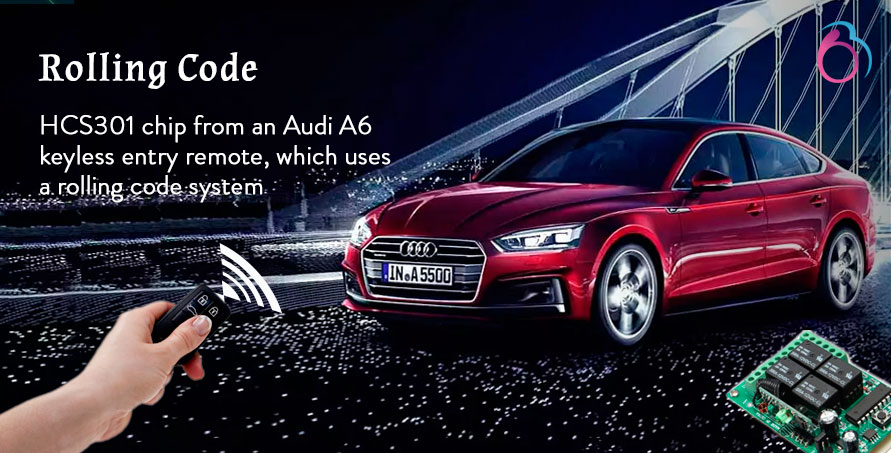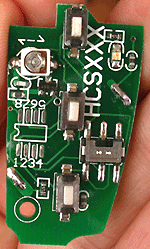Rolling Code

A rolling code transmitter is helpful for providing a highly secure encrypted RF (radio frequency) signal, playing a significant role in modern security systems. It ensures that unauthorized access is prevented by constantly changing the transmitted code.
This method is essential in protecting systems like vehicle keyless entry, garage door openers, and home security devices from hacking attempts.
The rolling code transmission process involves an encrypted RF signal, which comprises an interleaved rolling code and a trinary bit fixed code. The receiver decodes the encrypted RF transmission and validates the fixed code by recovering the rolling code.
It compares the received fixed and rolling codes with the stored codes and, if the signal is verified as emanating from an authorized transmitter, it generates a signal to activate an electric motor. This motor can be used to open or close a movable component, such as a garage door or vehicle locks.
How Rolling Code Works
Remote controls send a code via RF signals to a receiver. The receiver checks whether the code matches the expected code and then actuates a relay to open the device or unlock a door. In traditional remote controls, a fixed code is sent each time, which means the same code is transmitted during every operation.
While this method works, it is prone to security risks such as code grabbing, where an attacker intercepts and reuses the same code to gain unauthorized access.
Rolling code technology addresses this vulnerability. With rolling code-enabled remote controls, the system sends out a new, random code with each activation. This dynamic coding system ensures that the same code is never transmitted twice, preventing replay attacks. Even if a code is intercepted, it becomes useless because it won’t be accepted again by the receiver.

Modern Applications and Security Enhancements
Currently, in the automotive industry, many vehicles utilize rolling code systems for keyless entry. For example, the Audi A6 uses a keyless remote control system featuring the rolling code chip HCS301.
This chip transmits 66 data bits and is widely used in vehicle security, garage systems, and gate control mechanisms. The HCS301 employs the KeeLoq algorithm, a highly secure encryption standard that ensures every transmitted code is unique, adding an extra layer of protection.
In the 2024 and 2025 market, rolling code technology is expected to see even more sophisticated advancements, with increasing integration into IoT (Internet of Things) security systems.
As smart homes and connected devices become more common, rolling code technology will play an essential role in safeguarding entry points, preventing unauthorized access to doors, gates, and vehicles.
Moreover, newer algorithms and chipsets are being developed to enhance the security offered by rolling codes. Manufacturers are focusing on improving encryption strength, adding multi-factor authentication, and incorporating machine learning-based anomaly detection to identify potential security threats before they can cause harm.
The automotive sector, for instance, is expected to push further toward integrating biometric verification alongside rolling code systems for enhanced security in keyless entry systems.
Rolling Code vs. Fixed Code
One of the main distinctions between rolling code and fixed code systems is how they handle transmissions. Fixed code systems always send the same code each time the remote is triggered, making them vulnerable to attackers who can capture the code and reuse it.
In contrast, rolling code systems provide a much higher level of security, as the code is different with each use, and a captured code becomes invalid once transmitted.
Given the increase in smart home technologies, rolling code technology is now being incorporated into more devices beyond just cars and garage door openers. Everything from home security alarms to wireless entry systems in apartment buildings can benefit from the dynamic security features provided by rolling codes.
Future of Rolling Code Technology in 2024 and 2025
Looking ahead, the rise of cyberattacks and the ever-increasing need for security in both personal and commercial spaces will ensure that rolling code technology continues to evolve. By 2025, it’s expected that rolling codes will not only be used in high-security environments but will also see widespread adoption in consumer electronics, such as smart home devices, connected appliances, and even in wireless payment systems.
For example, digital wallets or payment cards using NFC (near-field communication) might adopt rolling code technology for an additional layer of security during transactions.
Similarly, in the automotive industry, vehicles may increasingly employ rolling code systems alongside GPS and biometric verification to reduce the risks of theft and unauthorized access.
Manufacturers are also exploring the possibility of integrating blockchain technology with rolling codes to create decentralized security frameworks for smart contracts and IoT devices.
This integration could significantly enhance the resilience of systems against cyberattacks, ensuring that even compromised devices remain secure through decentralized verification methods.
Conclusion
Rolling code technology has proven its effectiveness in providing a secure method of RF transmission, particularly in systems requiring high security, such as vehicle keyless entry and garage door systems. As of now, the HCS301 chip, using the KeeLoq algorithm, is a prime example of how rolling codes are being implemented to protect both commercial and personal property from unauthorized access.
As we move forward into 2024 and 2025, we can expect rolling code technology to become more advanced and integrated into a wide range of applications, from IoT devices to payment systems and beyond. With its ability to prevent replay attacks and code grabbing, rolling code technology is set to remain a crucial element in the ongoing effort to enhance security in an increasingly connected world.
Did you find this article useful? Let us know by leaving a comment below, or join us on Twitter and Facebook.




